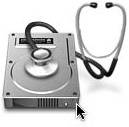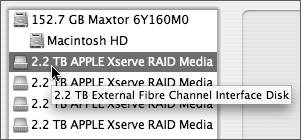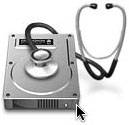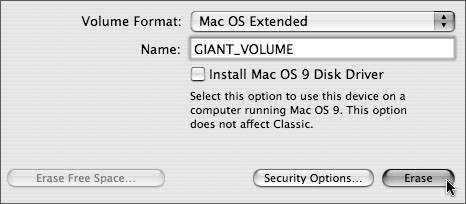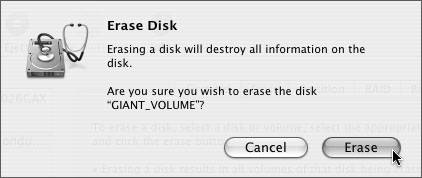Volume Creation
| Now it's time to initialize your storage system and turn it into a usable volume. You have two options. If you're initializing a striped array of separate drives, or aggregating the two controllers (called logical unit numbers or LUNs) of an Xserve RAID, use the first method that follows, "Creating RAID Sets." However, if you're simply mounting a device that will appear as a single device to the OS, such as a bridge array or a single controller of an Xserve RAID, use the second method, "Creating Volumes from Single-Host RAIDs." Creating RAID SetsCreating RAID sets with Apple's Disk Utility is a breeze. The hard partinstalling the appropriate hardware and driversis behind you. When you launch Disk Utility, you should see the devices, which means that the OS recognizes them. Then, you simply need to do a little dragging and dropping to create the RAID volume. We'll use this technique to create a volume from two scenarios: RAIDing together a series of devices to create a striped RAID 0, or RAIDing together a few host RAIDs, such as the two 7-drive LUNs of an Xserve RAID, to create a RAID X-0 configuration.
Creating Volumes from Single-Host RAIDsIn the case of storage devices with internal RAID controllers, these units will present only one device to the OS, through the host adaptor that they are attached to. For example, popular SCSI-to-ATA/SATA and Fibre-to-ATA/SATA units have internal RAID controllers, and as a result, will show up as a single device only through either the SCSI or Fibre Channel HBA card installed in your Mac. These drives are also easy to configure. Again, using Apple's Disk Utility, let's format this single-unit device into a Mac OS Extended volume.
Testing Read and Write SpeedsRight now is a good time to test the throughput, or read and write speeds of your newly created volume. What's critical here is to make sure that your volume will handle the speeds for the highest data rate of video you intend to work with. AJA and Blackmagic supply excellent drive speed test programs with their driver software, but there are other third-party programs such as Intech Software's Speed Tools (www.speedtools.com) and Lloyd Chambers' DiskTester (www.llc4.com/software/disktester/), which runs only in the Terminal but is quite versatile. |
EAN: N/A
Pages: 205
- Step 1.1 Install OpenSSH to Replace the Remote Access Protocols with Encrypted Versions
- Step 3.1 Use PuTTY as a Graphical Replacement for telnet and rlogin
- Step 3.2 Use PuTTY / plink as a Command Line Replacement for telnet / rlogin
- Step 4.6 How to use PuTTY Passphrase Agents
- Step 4.7 Using Public Key Authentication for Automated File Transfers
